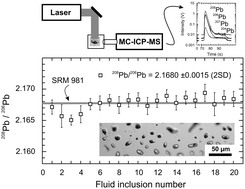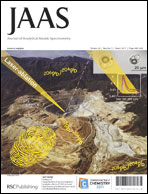This work establishes the analytical protocol for accurate Pb isotopic analysis of fast transient signals by multiple-collector ICP-MS instruments. Individual synthetic fluid inclusions of known Pb and Tl isotopic compositions (dissolved SRM 981 with or without SRM 997 from NIST, enclosed in quartz by a hydrothermal crack annealing technique) were liberated by 193 nm UV laser ablation (LA). Data were recorded on Faraday detectors, for which correction schemes for bias in amplifier response (“tau correction”) are presented and evaluated. tau-Corrected Pb isotope data reveal LA-induced isotope fractionation amounting to ∼0.5% amu−1 for Pb isotopes over the course of an entire fluid inclusion ablation. Instrumental mass bias correction was effected within-run using Tl provided by the fluid inclusion itself or admixed to the ablation aerosol via desolvated nebulization. Isotope ratios derived from the transient signals were either based on individual readings or on bulk signal integration, of which the latter produces significantly more accurate data. The external precision achieved by ablating SRM 610 glass with a 60 µm beam is ±0.011% (2 SD, relative) for 208Pb/206Pb and 207Pb/206Pb ratios and ±0.032% for Pb isotope ratios normalized to mass 204 (n = 18). Inclusion-to-inclusion reproducibilities (n = 11; ∼0.1 ng Pb per inclusion) are ±0.05% (2 SD; 208Pb/206Pb and 207Pb/206Pb) and ±0.13% (20xPb/204Pb), respectively; inclusions containing as little as 0.005 ng Pb returned ±0.1% and ±0.8%. These results are accurate as demonstrated by analysis of synthetic fluid inclusions containing SRM 981 Pb. The analytical protocol presented here for measuring isotope ratios on minute analyte quantities by multiple-collector ICP-MS in fast transient signal mode has great potential for applications to geochemical, archaeological, environmental and possibly biochemical problems.

You have access to this article
 Please wait while we load your content...
Something went wrong. Try again?
Please wait while we load your content...
Something went wrong. Try again?


 Please wait while we load your content...
Please wait while we load your content...